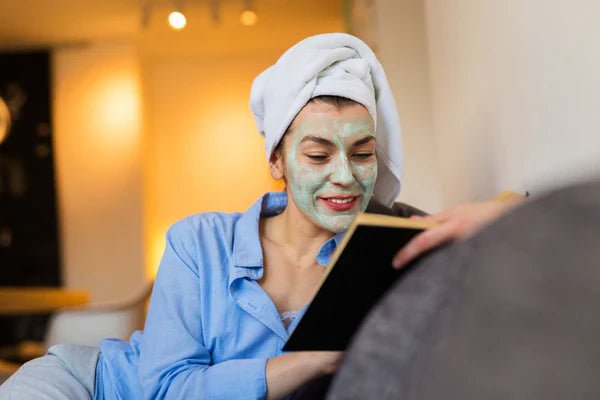Clay masks have been used in skincare for centuries thanks to their cleansing, detoxifying, and mineralizing properties. Their secret lies in their natural composition – clays are rich in micro- and macronutrients that support skin regeneration, remove excess sebum, and leave the complexion smooth and refreshed.
Today I'll tell you about the types of clays, how to choose a mask for your skin type, and when it's worth reaching for a cream alternative.
Why are clay masks so effective?
- Deep cleansing – clay absorbs impurities and excess sebum.
- Exfoliation of dead skin – gently smoothes the skin surface.
- Providing minerals – magnesium, silicon, calcium and zinc – support the healthy appearance of the skin.
- Anti-inflammatory effect – soothes irritations and supports regeneration processes.
- Mattifying the skin – the perfect solution for combination and oily skin.
Types of clays and their effects
1. White clay (kaolin)
The most gentle, recommended for dry and sensitive skin. Brightens, soothes, and improves elasticity.
2. Green clay
It cleanses strongly, has antibacterial properties and regulates sebum secretion – ideal for oily and acne-prone skin.
3. Red clay
Improves microcirculation, strengthens blood vessels, ideal for vascular skin.
4. Pink clay
It combines the properties of white and red clay, has a soothing and refreshing effect.
5. Yellow clay
Gently exfoliates, improves skin tone, and accelerates regeneration.
How to use clay masks?
- Apply a thin layer of the mask to cleansed skin.
- Avoid drying out completely – spray with water or hydrolate.
- Wash off after 10–15 minutes with lukewarm water.
- Apply a moisturizer to replenish the hydrolipid layer.
Disadvantages of clay masks that are worth knowing about
- They can dry out your skin if you leave them to dry completely.
- Some people experience skin tightening after washing it off.
- They require additional moisturization after application.
An alternative to clay masks – Orientana cream masks
If your skin is sensitive, dehydrated, or needs nourishment without drying out, cream masks are worth considering. They are rich in active ingredients that intensively regenerate, moisturize, and smooth the skin.
I especially recommend:
- Hello Daktyl – a nourishing mask with date extract, rich in antioxidants, supporting skin regeneration.
- Hello Papaja – a brightening papaya mask that smoothes and evens out skin tone.
- Tremella – an intensely moisturizing mask with snow mushroom, a natural source of plant hyaluronic acid.
These cream masks from Orientana are perfect both as an alternative to clays and as a complement to skincare – especially when your skin needs an extra dose of hydration and comfort.
Frequently asked questions about clay masks
1. What are clay masks?
These are cosmetics based on natural mineral clays that cleanse, refresh and provide the skin with valuable minerals.
2. How do clay masks work?
They absorb excess sebum, remove impurities and gently exfoliate dead skin.
3. Are clay masks good for all skin types?
Yes, but the choice of clay should be tailored to the needs of the skin – e.g. white for sensitive skin, green for oily skin.
4. How often can clay masks be used?
Most often 1-2 times a week, depending on the needs of the skin.
5. Do clay masks dry out the skin?
They can if allowed to dry completely; it's a good idea to wash them off while they're still slightly damp.
6. How to prepare a clay powder mask?
Mix the powder with water, hydrolate or yogurt to form a paste.
7. Can you add oils to a clay mask?
Yes, adding a few drops of vegetable oil will increase its nutritional properties.
8. Do clay masks help with acne?
Yes, green and bentonite clay in particular have antibacterial and anti-inflammatory effects.
9. Can clay masks be used overnight?
Not recommended – best to wash off after a maximum of 15–20 minutes.
10. What minerals are found in clay masks?
Including silicon, magnesium, calcium, iron, and zinc, which support the healthy appearance of the skin.
11. Are clay masks good for mature skin?
Yes, especially when combined with moisturizing products, they improve skin firmness and tone.
12. How to use clay masks in summer?
Same as in other seasons, but remember to use SPF protection, as skin is more sensitive after cleansing.
13. What is the difference between clay masks and cream masks?
Clay ones mainly cleanse, while creamy ones intensively moisturize and nourish.
14. Can clay and cream masks be used in the same treatment?
Yes, for example, alternately – once a cleansing clay, once a nourishing cream mask.
15. What cream masks should you choose after clay treatment?
I recommend Orientana cream masks – Hello Daktyl , Hello Papaja and Tremella , which will nourish and moisturize the skin after cleansing.
Clay masks are an excellent choice for cleansing your skin, reducing the appearance of pores, and improving its texture. Just remember to moisturize after use—or opt for cream masks like Hello Daktyl , Hello Papaja , or Tremella by Orientana, which combine care with comfort.









